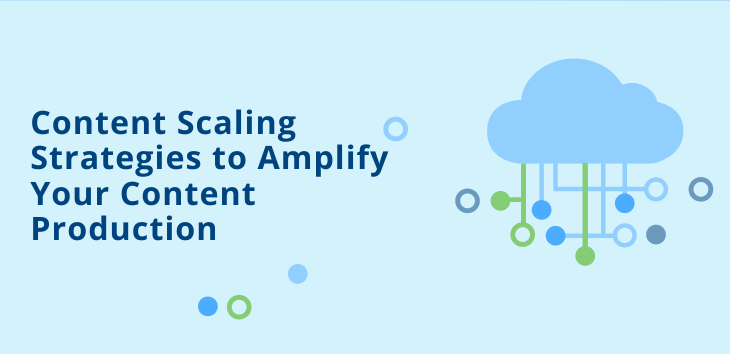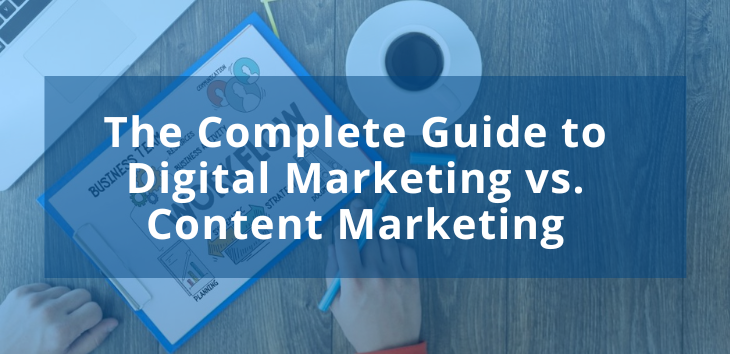Attention spans are fleeting, and competition is fierce. Your content needs to be more than high-quality — it needs to be everywhere. But content scaling doesn’t mean churning out endless blog posts or flooding social media. It’s a strategic method for amplifying your message, reaching wider audiences, and driving tangible results without sacrificing quality.
Consider this your ultimate guide to scaling content. We’re diving deep into strategies, tools, and real-world triumphs that will empower you to create content that resonates and dominates. AI-assisted brief creation, batch production, and content management systems are just the beginning.
Prepare to break free from the mold and make your content unstoppable.
What Is Content Scaling?
Content scaling is the strategic process of amplifying your content so it reaches more people. Let’s look at two core concepts:
- Multiplication: A single, well-crafted piece becomes the seed for a network of interconnected and repurposed content, maximizing its impact and longevity.
- Diversity: Content scaling embraces the full spectrum of content formats — blog posts, social media snippets, videos, podcasts, and infographics — to engage different segments of your audience and keep them hooked.
Content scaling is the future of content creation. It’s a strategic, data-driven approach that empowers you to reach wider audiences, build stronger brand awareness, and drive meaningful results.
Why Is Content Scaling Important?
Let’s look at the benefits of scaling content output:
- Expand reach: Scaling content allows you to reach a wider audience across various platforms and channels.
- Build trust and authority: Consistently delivering high-quality, relevant content positions your brand as a trusted resource and thought leader in your industry. This essentially establishes your company as a go-to expert in your field — the one people turn to for advice and solutions.
- Boost visibility: Optimizing your content for search engines can significantly improve your website’s ranking in search results, leading to increased organic traffic. Think of your website as a storefront on a busy street — a high ranking on search results is the equivalent of a prime spot on Main Street.
- Generate leads: Compelling content acts as a magnet, drawing potential customers to your brand. Offer valuable information and insights to capture their interest and convert them into qualified leads.
- Increase revenue: Content scaling drives tangible business results. Nurturing leads using targeted content throughout the customer journey accelerates conversions and boosts your bottom line.
Content scaling empowers you to connect with your audience on a deeper level, build brand loyalty, and ultimately drive sustainable growth. Work smarter, not harder, to amplify your message and achieve tangible business results.
Leverage Scalable Content for Brand Amplification
Scalable content acts as a megaphone for your brand’s unique voice. Consistently deliver high-quality, relevant content across various channels to increase visibility and reinforce brand identity. Having a consistent presence solidifies your brand in the minds of consumers, making you the go-to source for information, products, or services.
Still, beware of falling into the trap of producing quantity over quality. Losing the magic touch that made your content so engaging in the first place would be catastrophic.
How to Maintain High-Quality Content at Scale
Scaling content must never mean sacrificing quality. Maintaining — or, ideally, elevating — your standards is pivotal for long-term success. Here’s how to create a content engine that seamlessly delivers quality and quantity:
- Thorough intent and audience research
- Quality briefs
- QA, subject matter experts, and editors
- Personalization
- Clear expectations
- Diverse content mix
- A style guide
Thorough intent and audience research
Before writing a single word, learn about your audience’s needs, desires, and pain points. What questions do they ask? What information do they seek? This tells you about audience intent. Aligning content with intent ensures every piece resonates and delivers genuine value. Go beyond keyword research and think about connecting with your audience on a human level.
Quality briefs
A well-crafted brief is the blueprint for successfully scaled content. It sets clear expectations, outlines key messages, and provides direction for your content creators. Use your project brief to guide your team toward your goals and help them understand and capture audience intent. Invest time and maximize the use of technology to craft comprehensive briefs that leave no room for ambiguity.
QA, subject matter experts, and editors
Even the most talented content creators are prone to human error. That’s where quality assurance, subject matter experts, and editors come in. They’re a safety net to ensure content is error-free, factually accurate, and polished to perfection. Consider implementing a multi-step editing process, including automated checks and several layers of human review.
Personalization
Personalization is a marketing superpower. Tailor messaging to specific segments of your audience based on their interests, demographics, and stage in the buyer’s journey. Use dynamic content on your website, segment your email lists, and design ultra-personalized social media campaigns. Personalization should apply to audience segments — but you must also personalize content based on the platform you’re using.
Clear expectations
When working with a team of content creators, establishing clear expectations and deadlines is essential. This helps everyone stay on track and ensures that projects are completed on time and to a high standard. Utilize project management tools to assign tasks, track progress, and maintain open communication.
Diverse content mix
Don’t rely on a single content format. Experiment with different types of content, such as blog posts, videos, podcasts, infographics, and social media posts. This not only keeps your audience engaged but also allows you to reach different segments of your target market that may prefer different formats.
A style guide
A style guide is a document that outlines your brand’s writing style, tone of voice, and formatting guidelines. It ensures that all your scaled content production is consistent and adheres to your brand’s standards, regardless of who created it. This is especially important when working with multiple content creators or outsourcing content creation.
Maintaining quality is paramount, but it doesn’t have to be a Herculean task. You can leverage tools and technologies to streamline the content scaling process without sacrificing an ounce of excellence.
Techniques and Tools That Enhance Content Scaling
Ready to transform your content strategy into a well-oiled machine? These techniques and tools help you scale up content production, streamline your workflow, and maximize efficiency:
- Content management systems
- Batch content production
- AI writing assistants
Content management systems (CMSes)
Think of a CMS as your content’s air traffic control tower, orchestrating the seamless flow of information across your digital channels. It’s a centralized platform where you can:
- Store all your content assets — blog posts, articles, images, videos — in one easily accessible location.
- Enable your team to work together seamlessly, no matter where they are located. Say goodbye to endless email chains and version control nightmares.
- Schedule posts in advance, manage revisions effortlessly, and track content performance with built-in analytics. Let the machines do the heavy lifting so you can focus on the big picture.
- Implement search engine optimization best practices to amplify content to the right audience at the right time.
According to Alan Gleeson, CEO of Contento, 68% of the top 25 B2B SaaS companies in Ireland use WordPress as their CMS. While WordPress is a popular choice, research shows that options such as Contentful or Contento deliver a performance advantage in terms of site speed, which is a crucial factor for user experience and SEO.
Batch content production
If you’re overwhelmed by the sheer volume of content, batching is a productivity lifeline. Instead of jumping from task to task like a frantic squirrel, batch content production involves focusing on one specific type of content at a time.
This approach allows you to:
- Enter a state of flow and complete tasks more quickly and efficiently.
- Create a backlog of content, ensuring a steady stream of publications even when you’re juggling multiple projects.
- Dive into the subject matter, research thoroughly, and craft your message with precision.
Many successful content creators swear by batch content production. For example, content marketing expert Clint Mally recommends creating multiple long-form pieces of content in a single week, then repurposing them into social media posts, email newsletters, and other formats. With this technique, you maximize the impact of your best content while saving time and energy.
AI writing assistants
Artificial intelligence isn’t here to steal your job; it’s here to streamline and enhance your workflow. Generative AI is a sophisticated tool that can:
- Brainstorm new topics, headlines, and angles for content.
- Analyze keywords, identify content gaps, and enhance your content’s discoverability.
- Personalize your message to specific audiences based on their interests and demographics.
Technology is a powerful ally in your quest to scale content creation. From AI-powered brainstorming tools to templates, the right technology streamlines your workflow and enhances your creativity.
How Can Technology Help in Scaling Content Production?
Crafting top-notch content at scale isn’t a walk in the park. It takes time, creativity, and, typically, a whole lot of caffeine. The following tools are poised and ready to streamline your workflow, amplify your reach, and help you unleash your creative genius.
ChatGPT
Ever dreamed of having a writing partner who never sleeps, never complains, and always has a thesaurus handy? Meet ChatGPT.
Use it to:
- Quickly generate first drafts of content briefs, blog posts, or social media captions.
- Transform existing content into different formats, such as turning a blog post into a script for a short video.
- Analyze keywords and suggest improvements to enhance your content’s discoverability.
- Quickly create structured outlines and detailed briefs for your content team.
Pros of ChatGPT:
- Increased efficiency: Drafts content quickly, freeing up your team’s time for other strategic tasks.
- Versatility: Use it for various content types and formats.
- Scalability: Helps you generate a high volume of content without sacrificing quality.
Cons of ChatGPT:
- Requires human oversight: Always review and edit ChatGPT’s output to ensure accuracy and maintain your brand voice.
- Potential for generic content: Often produces content that lacks originality and can require extensive additional refinement.
- Ethical considerations: Be mindful of potential biases and limitations of AI-generated content.
- Cost: Free for basic use, with paid plans offering more advanced features.
Crowd Content’s Templates
Crowd Content’s content brief template and blog post templates enable you to consistently create content that’s structurally sound and visually appealing. Use them to:
- Save time and mental energy by following a proven formula for content creation.
- Ensure content aligns with your brand voice and messaging, creating a cohesive brand experience across all channels.
- Glean expert tips and insights on how to craft content that captivates and converts.
Pros of using CC templates:
- Simplified content creation process: No more staring at a blank page, wondering where to start.
- Improved content quality and consistency: Create content that adheres to your brand standards and resonates with your audience.
- Cost: Free to use, making it a valuable resource for content creators of all levels.
Cons of using CC templates:
- May not be suitable for all types of content or industries: Some customization might be necessary to adapt the templates to your specific needs.
- Requires some level of knowledge and experience: While the templates provide a helpful framework, you still need to bring your own expertise and creativity to the table.
Be sure to conduct regular maintenance checks to keep your content machine well-oiled. Let’s explore the metrics that help you calculate the success of scaled content and ensure it’s making an impact.
How Do You Measure the Success of Scaled Content?
Here’s how to measure content performance:
- Website traffic
- Engagement metrics
- Lead generation
- Conversions
Website traffic
Are more people visiting your site? Are they lingering longer and browsing your pages with interest? Tools such as Google Analytics tell you which web pages are most popular and where visitors get lost or leave too soon.
Let’s say you run an online store selling eco-friendly products. Tracking website traffic might show a spike in visitors after you publish a blog post about sustainable living tips. This tells you that this type of content resonates with your audience and gets them onto your site.
Engagement metrics
Engagement metrics reveal whether users are actually getting value from your content. Are they reading, watching, listening, sharing, and commenting? Are they hooked on your every word, or do they tune out after the first few lines? Metrics such as time on page, bounce rate, social shares, and comments are real-time representations of how engaging your content is.
Perhaps you create a series of videos demonstrating how to use your product. If viewers watch all the way through and leave positive comments, you know you’ve struck a chord.
Lead generation
Your content is a magnet for potential customers. Lead generation metrics tell you how many people are drawn to your brand. Are they subscribing to your newsletter, downloading your whitepaper, or filling out your contact form? Leads are the seeds of future sales, so nurturing them with valuable content is key.
Conversions
Conversions are the ultimate goal of any content marketing strategy. It’s the moment when a prospect raises their hand and says, “I’m in!” Whether it’s subscribing to your socials, making a purchase, signing up for a free trial, or requesting a demo, conversions are the proof that your content is performing as it should.
You’re practically an expert in scaling content by now. Let’s look at some real-world case studies of brands that successfully scaled their content efforts.
Successful Content Scaling Examples
These brands didn’t just dip their toes into content scaling — they dove in headfirst and emerged victorious. Their brand stories offer valuable insights for anyone looking to amplify their content’s impact:
BoConcept
Here’s a glimpse at how Danish furniture brand BoConcept, enhanced content scaling using AI and centralized marketing.
The challenge: BoConcept faced the formidable task of creating and adapting marketing campaigns for numerous products, channels, sub-brands, markets, and languages. Local production agencies struggled to maintain consistency and meet the brand’s high standards.
The solution: BoConcept centralized its brand marketing efforts and partnered with an AI-powered agency to streamline content production. This allowed the brand to create master campaigns that could be scaled and localized across 64 different languages, ensuring consistent messaging and brand voice across all markets. An extraordinary level of accessibility and global inclusivity are two of AI and content scaling’s true superpowers, helping brands reach customers around the world.
Paris Mechanical
Let’s look at HVAC company Paris Mechanical’s approach to scaling up using AI and automation.
The challenge: Paris Mechanical was experiencing rapid growth but struggling to keep up with the increasing demand for services. Its sales and marketing processes were largely manual, leading to bottlenecks and missed opportunities.
The solution: Paris Mechanical partnered with a consulting firm specializing in AI and automation to develop a scalable marketing strategy. It implemented a suite of tools, including HubSpot Marketing Hub, Unbounce, and Google Ads, to automate lead generation, capture, and nurturing. What’s more, it tapped into the power of AI tools to generate personalized content and streamline the quoting process.
What Strategies Can Manage Increased Content Volumes?
With great content comes great responsibility. As output ramps up, you need a strategy to keep scaled content organized, efficient, and aligned with your goals.
Here’s your roadmap to content scaling success:
- Assemble a strong content team
- Craft a content calendar
- Streamline your workflow
- Integrate into existing campaigns
1. Assemble a strong content team
Assemble a strong team of content specialists, each with their own unique skills and expertise, including:
- Content strategists: The masterminds behind the overall content vision and direction.
- Writers: The wordsmiths who bring your ideas to life with captivating prose that sings with your brand voice.
- SMEs: The frontline industry experts who edit for technical accuracy and enhance your content’s authority.
- Editors: The grammar stalwarts who ensure content is polished and error-free.
- Designers: The visual wizards who create eye-catching graphics and layouts.
- SEO specialists: The search engine whisperers who optimize your content for maximum visibility.
- Social media managers: The social butterflies who amplify your content across various platforms.
2. Craft a content calendar
A content calendar is a visual representation of your planned content, including:
- Topics: What are you going to write, record, or film about?
- Formats: Will it be a blog post, video, infographic, or something else?
- Channels: Where will you publish and promote your content?
- Deadlines: When will each piece of content be ready?
3. Streamline your workflow
Streamline your workflow by:
- Automating repetitive tasks such as scheduling social media posts, sending email newsletters, and delivering analytics reports.
- Creating reusable templates for different content types to save time and maintain consistency.
- Using project management tools to track progress, assign tasks, and collaborate with team members seamlessly.
4. Integrate into existing campaigns
Integrate content into your broader marketing campaigns to maximize its impact. This means:
- Sharing it across your social media channels, email newsletters, and other marketing channels.
- Repurposing your blog posts into videos, podcasts, and shareable infographics to reach different audiences.
- Using content as a way to guide potential customers through the buying journey.
- Creating a cohesive and powerful brand narrative that resonates with your audience, building a community and driving them toward action.
Content Scaling Limitations and How to Address Them
Scaling content isn’t always a smooth ride. There are a few bumps in the road you might encounter along the way. But don’t worry. With a little foresight and strategic planning, you can overcome these challenges and keep your content engine purring:
- Maintain quality at scale: As output increases, it can be tempting to cut corners to save time and resources. However, this is a recipe for disaster. Quality should always be your top priority. To maintain high standards, invest in skilled content creators, implement rigorous editing processes, and use tools to automate time-consuming tasks.
- Avoid content fatigue: Publishing a large volume of content doesn’t guarantee engagement. If your content becomes repetitive or irrelevant, audiences tune out. To avoid content fatigue, create diverse content that appeals to different segments of your audience. Experiment with new formats, topics, and angles to keep things fresh and engaging.
- Measure ROI: Content scaling requires an investment of time, money, and resources. Make sure you track ROI carefully to ensure your efforts are paying off. Use analytic tools from Google and social media to measure your content’s impact on engagement metrics such as website traffic, time on page, and conversion rate.
- Adapt to algorithm changes: Social media algorithms are constantly evolving, and that can impact your content’s visibility and reach. Stay up-to-date on the latest changes and adjust your strategy accordingly. Experiment with different posting times, formats, and content types to find what works best for your audience.
- Stay ahead of the competition: The content landscape is constantly evolving. To stay ahead of the curve, you must constantly learn and adapt. Follow industry trends, experiment with new technologies, and keep an eye on what your competitors are doing.
Proactively addressing these challenges ensures your content scaling efforts are sustainable and aligned with your business goals.
See How to Scale Your Content Now
If content scaling sounds like a lot of effort and expense, that’s because it is. Even large brands with huge marketing budgets can struggle to manage each step of the process in-house. Let’s look at the pros and cons of outsourcing versus in-house content scaling.
The Creation Process: In-House versus Outsourcing Scalable Content
Should you build your content team in-house or outsource to the pros? There’s no one-size-fits-all answer. The best approach depends on your specific needs, budget, and existing resources.
First, let’s explore the pros and cons of in-house content scaling:
- Pros: More control and the ability to iterate and experiment quickly if you have an existing in-house content team.
- Cons: It’s extremely expensive and time-consuming to build a team of skilled strategists, content creators, editors, quality assessors, AI experts, and SMEs from scratch.
Now, let’s study the pros and cons of outsourcing content scaling:
- Pros: Access to a wide pool of talent and expertise, making it a cost-effective solution for businesses. Outsourcing also offers the flexibility to scale up or down as needed.
- Cons: Less control over the creative process and potential for communication challenges.
Many businesses opt for a hybrid approach, combining in-house expertise with the flexibility and scalability of outsourcing. This allows them to leverage the strengths of both models while mitigating the weaknesses.
For guidance on how to find the right content creators for your needs, check out our article: How to Find Content Creators [LINK TO FORTHCOMING ARTICLE].
Your Content Scaling Strategy
Content scaling is a marathon, not a sprint. It requires a strategic mindset and a relentless commitment to quality. Following the strategies and using the tools outlined in this guide will get you on your way to creating a powerful content engine that drives results, fosters brand loyalty, and propels your business to new heights.
Always keep in mind that increasing quantity must never compromise quality. Prioritize providing helpful, insightful, and actionable content that exceeds your audience’s expectations.
Don’t just take our word for it. Go forth and experiment. Test different approaches, track your results, and refine your strategy over time.




